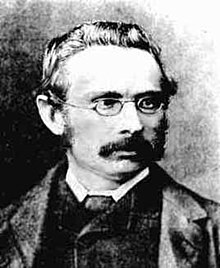| George ChrystalFRSE FRS | |
|---|---|
 George Chrystal (1851–1911) George Chrystal (1851–1911) | |
| Born | (1851-03-08)8 March 1851 Old Meldrum, Scotland, UK |
| Died | 3 November 1911(1911-11-03) (aged 60) Edinburgh, Scotland, UK |
| Resting place | Foveran Churchyard, Aberdeenshire |
| Nationality | Scottish, UK |
| Alma mater | University of Aberdeen Peterhouse, Cambridge |
| Known for | Experimental verification of Ohm's law Chrystal's equation |
| Spouse | Margaret Anne Balfour (1870-1903 her death) |
| Awards | Royal Medal (1911) |
| Scientific career | |
| Fields | Physicist and mathematician |
| Institutions | University of St Andrews University of Cambridge University of Edinburgh |
| Academic advisors | James Clerk Maxwell |
| Notable students | Joseph Wedderburn |


George Chrystal FRSE FRS (8 March 1851 – 3 November 1911) was a Scottish mathematician. He is primarily known for his books on algebra and his studies of seiches (wave patterns in large inland bodies of water) which earned him a Gold Medal from the Royal Society of London that was confirmed shortly after his death.
Life
He was born in Old Meldrum on 8 March 1851, the son of Margaret (née Burr) and William Chrystal, a wealthy farmer and grain merchant.
He was educated at Aberdeen Grammar School and the University of Aberdeen. In 1872, he moved to study under James Clerk Maxwell at Peterhouse, Cambridge. He graduated Second Wrangler in 1875, joint with William Burnside, and was elected a fellow of Corpus Christi. He was appointed to the Regius Chair of Mathematics at the University of St Andrews in 1877, and then in 1879 to the Chair in Mathematics at the University of Edinburgh. In 1911, he was awarded the Royal Medal of the Royal Society for his researches into the surface oscillations of Scottish lochs.
He was a contributor to the drafting of the Universities (Scotland) Act 1889, and was one of the founders of the Edinburgh Mathematical Society.
He was elected a Fellow of the Royal Society of Edinburgh in 1880, his proposers including James Clerk Maxwell. He was awarded the Society's Keith Medal for 1879-81 and their Gunning Victoria Jubilee Prize for the period 1904–8. He served as Vice President of the Society from 1895-1901 and General Secretary from 1901–1911. He is credited with instigating the move of the Society from the Mound to George Street.
He was awarded honorary doctorates (LLD) from the University of Aberdeen in 1887 and the University of Glasgow in 1911.
In later life he is listed as living at 5 Belgrave Crescent in western Edinburgh.
The mathematician Alexander G. Burgess trained under him.
He grew ill in 1909 and this worsened early in 1911, leading the University to grant him leave of absence from April of that year. A work-free summer did not improve him. He died on 3 November 1911 at 5 Belgrave Crescent in Edinburgh. He is buried in Foveran Churchyard in Aberdeenshire.
Family

He married Margaret Anne Balfour (1851-1903) in 1879. She died before him and is buried in the northern Victorian extension to Dean Cemetery with their son Walter MacDonald Chrystal who died in infancy. They had four sons and two daughters.
Publications
- Chrystal, George (May 1999) . Algebra: An Elementary Text-Book for the Higher Classes of Secondary Schools and for Colleges. (Volumes I & II) (7 ed.). American Mathematical Society. ISBN 978-0-8218-1931-9. (Out of copyright: 1900 and subsequent editions are available in reprint or online.)
- Three articles within the 1911 edition of Encyclopædia Britannica: Pascal, Blaise; Perpetual Motion; and Riemann, Georg Friedrich Bernhard.
References
- Knott, C. G. (9 November 1911). "obit. Prof. George Chrystal". Nature. 88 (2193): 47–49. doi:10.1038/088047b0.
- "Chrystal biography". www-history.mcs.st-and.ac.uk. Retrieved 28 December 2017.
- C D Waterston; A Macmillan Shearer (July 2006). Former Fellows of The Royal Society of Edinburgh, 1783–2002: Part 1 (A–J) (PDF). Royal Society of Edinburgh. ISBN 090219884X. Archived from the original (PDF) on 24 January 2013. Retrieved 18 September 2015.
- "Chrystal, George (CHRL871G)". A Cambridge Alumni Database. University of Cambridge.
- Chisholm, Hugh, ed. (1922). "Chrystal, George" . Encyclopædia Britannica (12th ed.). London & New York: The Encyclopædia Britannica Company.
- C D Waterston; A Macmillan Shearer (July 2006). Former Fellows of The Royal Society of Edinburgh, 1783–2002: Part 1 (A–J) (PDF). Royal Society of Edinburgh. ISBN 090219884X. Archived from the original (PDF) on 24 January 2013. Retrieved 18 September 2015.
- Obituary of George Chrystal:The Times, 4 November 1911
- "Chrystal and the RSE".
- Edinburgh and Leith Post Office Directory 1890-1
- Comrie, Peter (1933). "Alexander G. Burgess, M.A., D.SC, F.R.S.E." Proceedings of the Edinburgh Mathematical Society. 3 (4): 300. doi:10.1017/S0013091500027395.
- Obituary of George Chrystal: The Scotsman, 4 November 1911
- "Home - Archives Hub" (PDF).
External links
- [REDACTED] Works by or about George Chrystal at Wikisource
- O'Connor, John J.; Robertson, Edmund F., "George Chrystal", MacTutor History of Mathematics Archive, University of St Andrews
- Algebra: An Elementary Text-Book for the Higher Classes of Secondary Schools and for Colleges. Volume I, Volume II